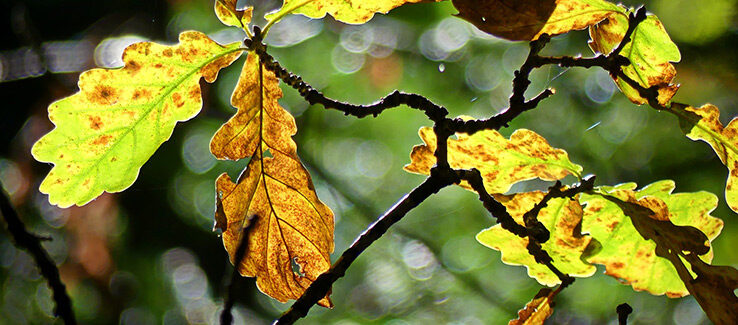We all know the importance of chlorophyll in our plants; how it brings our plants their gorgeous green color and how that helps them absorb energy from sunlight. But what does it mean when our leaves go from green to yellow? According to University of Illinois’ “Home, Yard & Garden Pest” newsletter on July 11th, 2016, this may mean they are chlorotic, a condition in which leaves turn yellow (chlorosis) as a result of destruction of chlorophyll or lack of chlorophyll production. The Midwest is known for the high pH balances in our soil and this, in turn, affects plant growth and health.
From a distance, we can see affected leaves appear to be a bright yellow in hue. With a closer look, these leaves are yellow-green with dark green veins. As chlorosis intensifies, leaves can develop a brown flecking and large dead areas in our trees. In some of the more severe cases, the entire leaf may become cream-colored, while the tips and margins of the leaves turn brown, according to Purdue University’s “Iron Chlorosis of Trees and Shrubs” article. You may also see your trees showing signs of lime buildup around the crowns of their trunks. If untreated, a tree with chlorotic symptoms may decline over time and eventually die.
Iron Deficiency: A Common Cause of Chlorosis
Soil pH: Iron is needed for the production of chlorophyll but the lack of iron that our trees are receiving is because of the high pH balances in our soil. The high pH balance is due to the lime content that is found in Midwest subsoil which tends to lock up iron, making it inaccessible to tree roots. Irrigation over several years with hard water provides additional lime, intensifying the problem (“Home, Yard & Garden Pest” July 11th, 2016). Affected trees are commonly found growing in close proximity to sidewalks, driveways, gravel parking lots, and foundations constructed of limestone bases.
Poor Soil Drainage: Inadequate drainage can lead to waterlogged roots, hindering the tree’s ability to absorb nutrients, including iron.
Competition with Other Nutrients: Excessive levels of certain nutrients, such as phosphorus, can interfere with iron absorption by tree roots.
Manganese Deficiency: Another Culprit of Chlorosis
Soil pH: Manganese is another essential micronutrient for trees, aiding in various functional processes, including photosynthesis. A deficiency in manganese can manifest as chlorosis, often accompanied by specific symptoms.Similar to iron, manganese availability is influenced by soil pH. Extremely high or low pH levels can limit manganese uptake by tree roots.
Excess Iron: Interestingly, an excess of iron in the soil can antagonize manganese uptake, leading to manganese deficiency even if sufficient manganese is present in the soil.
Recognizing the Symptoms
Detecting chlorosis due to iron or manganese deficiency involves observing certain distinct symptoms:
- Yellowing Leaves: The most prominent sign is the yellowing of leaves while the veins remain green. This is the trademark of chlorosis.
- Interveinal Chlorosis: Both iron and manganese deficiencies often result in interveinal chlorosis, where the area between leaf veins turns yellow while the veins themselves remain green.
- Reduced Growth: Affected trees may exhibit stunted growth due to reduced photosynthesis and energy production.
Are you starting to wonder if some of the leaves on your trees are turning yellow instead of staying green? By addressing the micronutrient deficiencies and providing the necessary care, you can bring your trees back to green. The most effective way to find which element your tree is missing is to reach out to an arborist at Homer Tree Care. From severe to moderate cases of chlorosis, our arborists can evaluate your trees to see what options are available to save your green!

